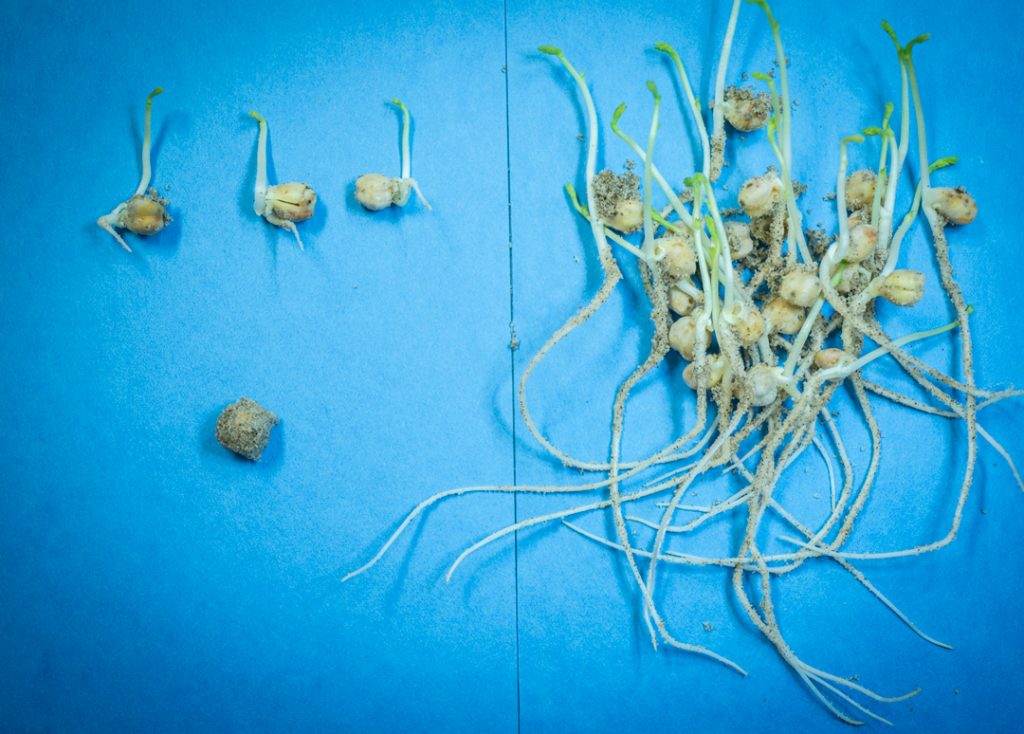QUALITY CONTROL
BY GEOFF GEDDES • PHOTOS COURTESY OF SEED CHECK TECHNOLOGIES
While school exams can cause anxiety, testing seed can net valuable quality information and peace of mind. “Testing of any seed at harvest, as well as testing throughout storage, is very important,” said Sarah Foster, president and senior seed analyst at 20/20 Seed Labs in Nisku. “Seed is at its prime when it first comes off the field. If you store it at the right moisture level, dry it when necessary and monitor it in the bin, you can maintain it in prime condition.”
If testing indicates the quality is high when it goes in the bin, continued testing can ensure it remains high throughout storage. As with any commodity, the more you know about it, the better positioned you are to address issues early on.
“When seed is on the moist side, you can get bacteria growing in the bin that heats up in pockets and leads to abnormal seedlings,” said Morgan Webb, accredited seed analyst and co-owner of Seed Check Technologies in Leduc. “On the other hand, seed that is too dry can experience mechanical damage, especially with peas, lentils and beans, but this may happen even in cereals. In that case, the plant embryo could crack, and the plant will grow without the structures needed to produce a mature, healthy plant.”
While knowing why to test is a good start, knowing what to test for ensures you measure what matters most. “The main tests we advise for growers are germination, vigour and disease, including a complete fungal screen,” said Foster. “It is also not a bad idea to have the thousand kernel weight (TKW) taken for your seeds.”
VIGOUR IS VITAL (VIM IS OPTIONAL)
Vigour testing used to be hyper-focused on strength. Is this seed strong enough to be planted in cold soils? How will it perform in a Canadian spring that is early and wet? According to Foster, however, the scope of vigour testing has expanded.
“I think the name ‘vigour’ for the test may have to be changed. We now have all kinds of technology that we can use to test the tolerance, endurance and hardiness of seeds.”
Such testing often involves imposing the dual stressors of excessive heat and moisture on seeds in storage to gauge the reaction and impact on performance.
“We literally send seeds into a state of panic. We create rapid respiration with heat and moisture, emulating heating and/or longevity in the bin,” said Foster. “If they have strong genetics, some seeds can withstand periods of high temperature and high moisture in the bin for a short time. This is called the accelerated ageing test, and the seeds that perform well will excel in the field.”
Assessing vigour can also involve a cold test in which seeds are put into wet soil or sand at low temperatures, 5 C for wheat and 6 C for barley. In this way, testers determine how quickly a seed can develop in a short time under stressful conditions.
Then there is electrical conductivity (EC) testing, which looks at seed coat integrity. “Is the seed coat cracked? If so, are they big or small cracks? Are the internal structures of the seed sound?” said Foster. “The EC test measures the amount of sugars and starches that leach into the water from the seeds. This gives us a vigour value for when the seed should be planted, and if it should be planted at all.”

TESTING! TESTING!
Germination is another critical focus of seed testing, and for good reason, as it gauges the viability of seeds. “For this aspect, we plant seeds under ideal conditions and evaluate them based on the number of seedlings that will turn into normal, healthy plants,” said Webb. Most cereals are tested for germination at 20 C. Grown in sterile media, they receive just the right amount of light and moisture.
More testing is better, so farmers will often get a TKW test as part of their seed scrutiny. “If you want a clear idea of where your seeding rate must be to reach your target plant population, TKW is a good choice,” said Devin Hartzler. He farms 3,000 acres of grains and oilseeds on his farm near Carstairs. “How many seeds per linear foot do we need to plant to reach that target?”
Even if your seed passes the above tests, it could be for naught when disease strikes. Because seeds can’t take sick days, health can be closely tied to wealth. “Disease testing is valuable for keeping tabs on what pathogens to watch for from year to year,” said Foster. “Some diseases are always present, while other ones vary depending on the weather. For example, in years where there is a lot of moisture during flowering, we often see high levels of Fusarium in cereals. One year may see only a single big disease threat, while others have four or five.”
In general, 20/20 Seed Labs focuses on five pathogenic fungi categories that tend to cause the most severe diseases. Cochliobolus sativus causes seedling blight, foot and root rot or spot blotch, also known as leaf blight. Fusarium graminearum is the pathogen behind Fusarium head blight (FHB), which produces Fusarium damaged kernels (FDK). Additional members of the Fusarium genus cause seedling blight, root and crown rot and head blight. Fungi of the Pyrenophora genus cause leaf blight, also known as leaf stripe, net blotch and tan spot, as well as seedling blight in oats. Finally, the Septoria genus causes shrivelled grain similar to FDK, leaf lesions with dark patches and leaf blotch.
Foster points out it is not uncommon for between two and five per cent of kernels tested to be infected with any one of these diseases individually. Seeding of cereals when testing determines a Fusarium graminearum infection rate of five per cent or higher, should be carefully considered. When infection levels of any one of these diseases is higher than eight per cent, seed treatments may not provide the necessary control of the pathogen.
“A fungal screen is like going to the doctor for a checkup,” said Foster. “As part of the process, we give growers the disease thresholds, so they know when paying for seed treatment might be warranted and when they can save their money.”
To keep it “interesting,” there are always new plant diseases emerging. When it comes to such threats, ignorance is never bliss. “Last year, bacterial leaf streak was a big concern,” said Foster. “It isn’t technically a new disease, but it was suddenly detected in many fields around central Alberta. In response, we quickly created a test for it. We found that this disease has been slowly creeping into the province, so testing is critical to keep tabs on the threat.”
To conduct effective seed testing, timing is everything. “We recommend growers test for vigour and germination in the fall,” said Webb. “Once they have handled and processed their seed, they should redo those two tests to ensure that everything went well during storage.”
Especially during storage, what you don’t know can hurt you. Foster urges vigilance. Given that 2023 was a tough growing season, some view post-harvest seed testing as even more important than in years past. “This year, it’s crucial to monitor what is happening in your bins throughout the season,” said Foster. “From the moment you harvest to when you are going to seed your fields, you should test vigour and germination at least three times: right after harvest, in January, and again in March just before seeding. I also advise testing for disease following harvest.”
A first test might look good, but then a vigour issue will appear. This may happen because the seed didn’t fully mature in the field or became too wet or too dry. If there was an early frost, this may have damaged the cell structure of the seed.
“When someone is not monitoring the bins or quality of the product in storage, they often won’t realize that, while their germination is at 100 per cent, their vigour might be only 85 per cent,” said Foster. “Maybe something is wrong with the seedling that they haven’t yet detected. Usually in storage, germination can stay high for six months, whereas vigour may drop off rapidly if there is a hidden defect, especially in growing seasons like 2023. In times like these, you really need to dig in and find out just how solid that seed is.”
“One thing we are seeing frequently this year is areas that had moisture late, with a lot of rain in July when plants were already at the flowering stage,” said Webb. “As a result, growers are burdened with a high incidence of seedborne diseases like FHB. If you get the perfect storm of too much heat and excess moisture, those are the ideal conditions for diseases like FHB to really take off.”
Of course, with the wild weather swings that are often seen in Alberta, some areas had the opposite problem this past growing season. “Where farmers had to deal with drought conditions, it is more important than ever to do a TKW test on their seed,” said Foster. “In a dry growing season, seeds tend to be smaller than usual, meaning you will have more seeds per gram, so the TKW will aid in revising seeding rates to account for that change.”
For farmers, even in the best of years, there is a lot at stake in terms of good grain storage and seed performance in the following season. “The biggest risk with untested seed is losing quality,” said Foster. “If you’re not closely monitoring your seeds in storage, you may have mold that you’re not aware of that causes clumping and can spread quickly if not detected early on. This could lead to a total loss of germination, and once that happens, there is not much you can do to recover.”

LOTS TO LOSE
Seed quality stakes are also high across the industry. “For pedigreed seed dealers, we must be able to tell customers exactly what they are getting, so they can plan their seeding rates and know how much to book for the spring,” said Brian Ellis, president of the Alberta-British Columbia Seed Growers. On his 3,500-acre farm near Olds, Ellis grows pedigreed wheat, barley, peas, lupins, fava beans and commercial canola. “We also need to ensure that as seed dealers we have no surprises. If we go ahead and clean all our seed lots, take orders, wait to do seed testing in the spring and find issues, it leaves customers scrambling for other options, and that’s not good for our business or for our customers’ spring planning.”
As a further complication, dealers who cannot meet the minimum standards for pedigreed seed must dispose of those seed lots into the commercial system, providing them less revenue for seeds that are very expensive to produce.
To affix a pedigreed seed tag, a germination test is mandatory as prescribed by the Canadian Seed Growers’ Association. While additional tests are not required, Ellis joins others in advising vigour, disease and TKW testing. “You only get to plant once per year, so you want to give yourself the best chance of success, and seed testing is a big part of that,” said Ellis.
“At one time it was legislated that if you planted your own seed, you had to have a Fusarium test done,” added Ellis. “Although that’s no longer the case, I hope growers who got in the habit keep testing for that.”
From the farmer viewpoint, Hartzler is a big proponent of testing and encourages others to follow his lead, even when it might seem less than urgent. He has learned the hard way to avoid cutting corners. “We’ve sent samples away for testing for a long time now,” he said. “At first, we only did the germination and vigour testing before we cleaned our seeds. Last year, though, we got caught with field peas that were under 50 per cent germination, so now we test after cleaning as well.”
“When I was a kid, dad did his own test by counting out 100 seeds, putting them in a jar in the dark and getting them to sprout,” said Hartzler. “Nowadays, testing labs are easy to access and give you a wealth of information to support your business.”
Given the clear benefits, why not test? In farming, where costs always seem to increase, testing is also available at a bargain. Hartzler gave an example. “I pay $28 per bin for my durum and $31 for peas, so I have no complaints about the price.”
As farm size increases, the case for testing escalates. “As farms become larger and more progressive, why would they jeopardize a multi-million-dollar operation to save $200 on testing?” said Ellis. “It just doesn’t make sense.”







Comments